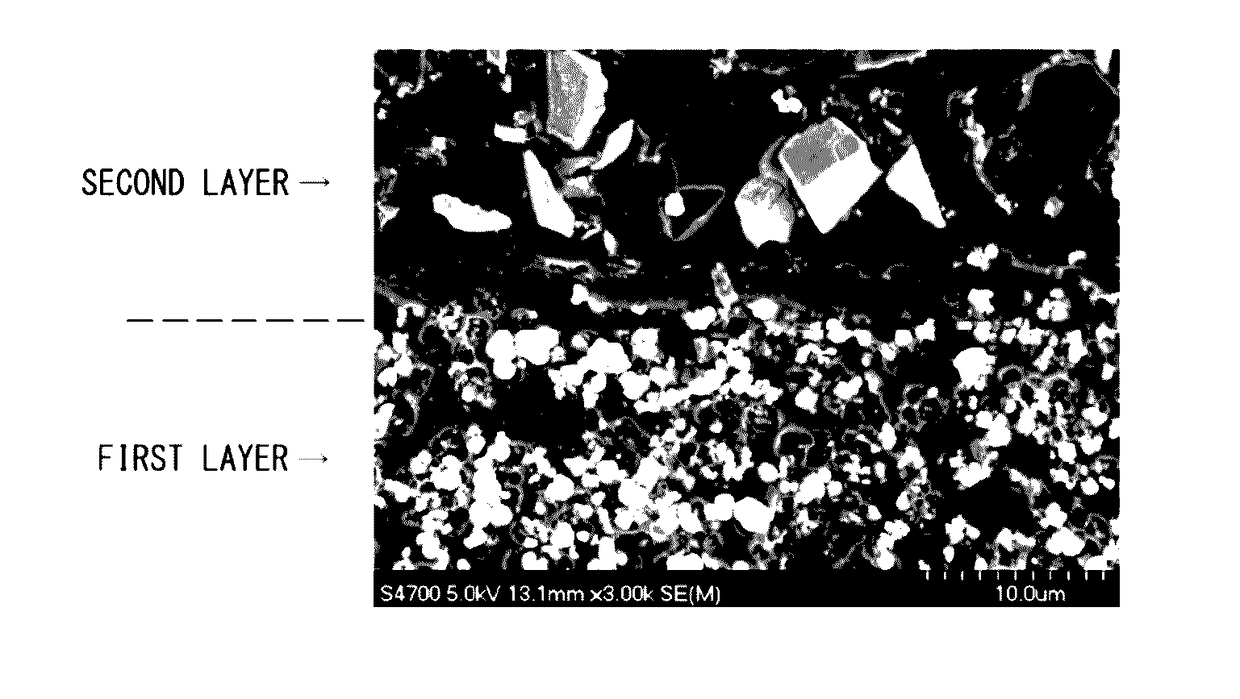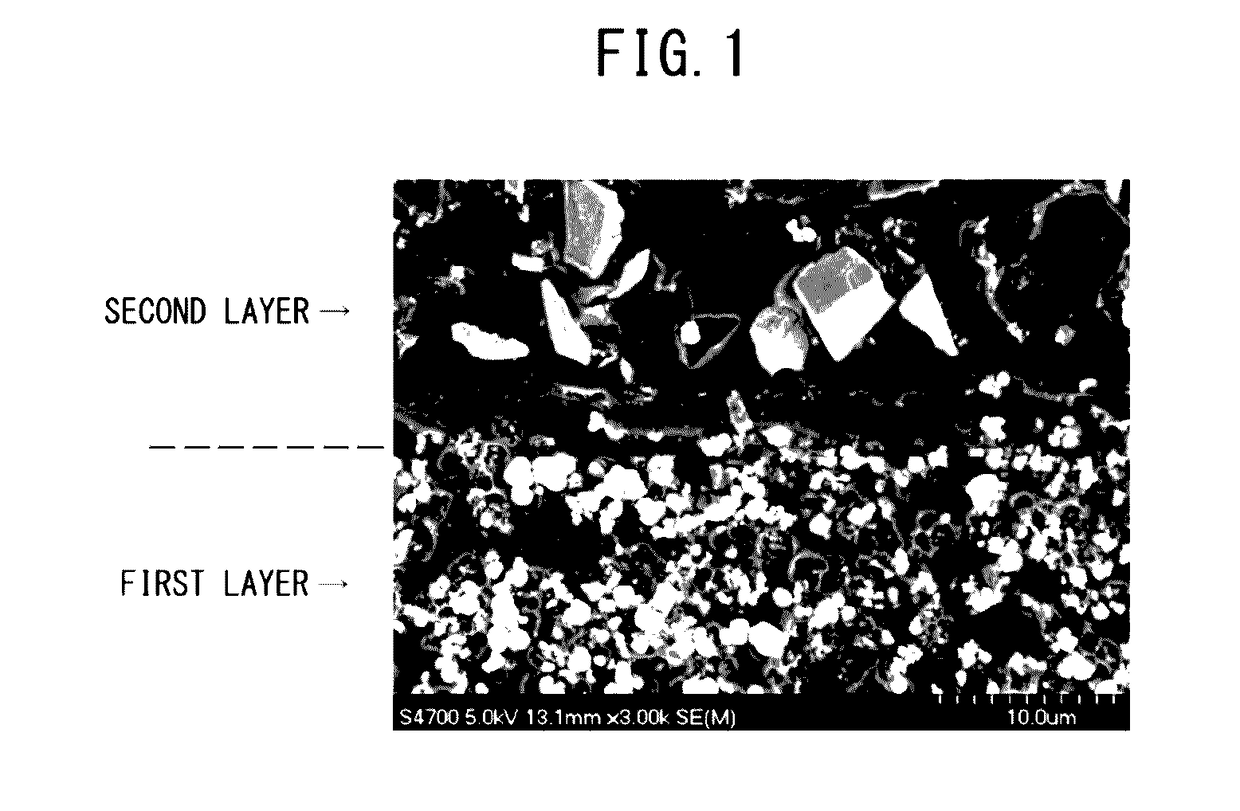Carbon-based acoustic matching layer and method for producing same
a technology of acoustic impedance and carbon fiber, applied in the direction of mechanical vibration separation, instruments, electrical transducers, etc., can solve the problems of uniform coating thickness, delamination and working temperature, limitation of the amount of change in acoustic impedance in the direction of thickness, etc., to achieve the effect of reducing the amount of change in acoustic impedance, and reducing the amount of loss
- Summary
- Abstract
- Description
- Claims
- Application Information
AI Technical Summary
Benefits of technology
Problems solved by technology
Method used
Image
Examples
example 1
[0072]One part of p-toluenesulfonic acid as a curing agent was added to 30 parts of furan resin (VF-303, Hitachi Chemical Co., Ltd.) as an amorphous carbon source and 70 parts of tungsten carbide (NCWC10, Nikkoshi Co., Ltd., particle size: 1.2 μm) as filler particles, followed by adequately stirring using a high-speed emulsifier / disperser (Model 2.5 Homomixer Mark II, Primix Corp.) and subjecting to a vacuum degassing procedure to prepare a solution for a sheet-like first layer. This solution was poured into a mold having a thickness of 0.7 mm and then cured to obtain a first layer.
[0073]Then, a second layer was laminated onto the resulting sheet-like first layer. More specifically, 1 part of p-toluenesulfonic acid was added to 50 parts of furan resin and 50 parts of titanium carbide (Japan New Metals Co., Ltd., particle size: 1.9 μm) followed by adequately stirring and subjecting to a vacuum degassing procedure to prepare a solution for the second layer. This solution was poured in...
example 2
[0075]One part of p-toluenesulfonic acid as a curing agent was added to 30 parts of a phenol resin (HP3000A, Asahi Yukizai Corp.) and 70 parts of tungsten carbide, followed by adequately stirring and subjecting to a vacuum degassing procedure to prepare a solution for a sheet-like first layer. This solution was coated at a thickness of 30 μm using the No. 542-AB Automatic Film Applicator (Yasuki Seiki Seisakusho, Ltd.) and then cured to obtain a sheet-like first layer.
[0076]Then, a second layer was laminated onto the resulting sheet-like first layer. More specifically, 1 part of p-toluenesulfonic acid was added to 40 parts of furan resin and 60 parts of double carbide (tungsten / titanium carbide) (WC-TiC50 / 50, Japan New Metals Co., Ltd., particle size: 1.0 μm) followed by adequately stirring and subjecting to a vacuum degassing procedure to prepare a solution for the second layer. This solution was coated to a thickness of 30 μm on a sheet molded as the first layer and then cured to ...
example 3
[0079]One part of p-toluenesulfonic acid as a curing agent was added to 50 parts of furan resin and 50 parts of tungsten carbide, followed by adequately stirring and subjecting to a vacuum degassing procedure to prepare a solution for a first layer. This solution was coated at a thickness of 30 μm and then cured to obtain a sheet-like first layer.
[0080]Then, a second layer was laminated onto the resulting sheet-like first layer. More specifically, 1 part of p-toluenesulfonic acid was added to 70 parts of furan resin and 30 parts of titanium oxide (KA-15, Titan Kogyo Ltd., mean particle diameter: 0.5 μm) followed by adequately stirring and subjecting to a vacuum degassing procedure to prepare a solution for the second layer. This solution was coated to a thickness of 30 μm on a sheet molded as the first layer and then cured to obtain a second layer.
[0081]Further, a third sheet was laminated on the resulting sheet-like laminate comprising the first layer and second layer. More specifi...
PUM
| Property | Measurement | Unit |
|---|---|---|
| particle size | aaaaa | aaaaa |
| thickness | aaaaa | aaaaa |
| particle size | aaaaa | aaaaa |
Abstract
Description
Claims
Application Information
 Login to View More
Login to View More - R&D
- Intellectual Property
- Life Sciences
- Materials
- Tech Scout
- Unparalleled Data Quality
- Higher Quality Content
- 60% Fewer Hallucinations
Browse by: Latest US Patents, China's latest patents, Technical Efficacy Thesaurus, Application Domain, Technology Topic, Popular Technical Reports.
© 2025 PatSnap. All rights reserved.Legal|Privacy policy|Modern Slavery Act Transparency Statement|Sitemap|About US| Contact US: help@patsnap.com


